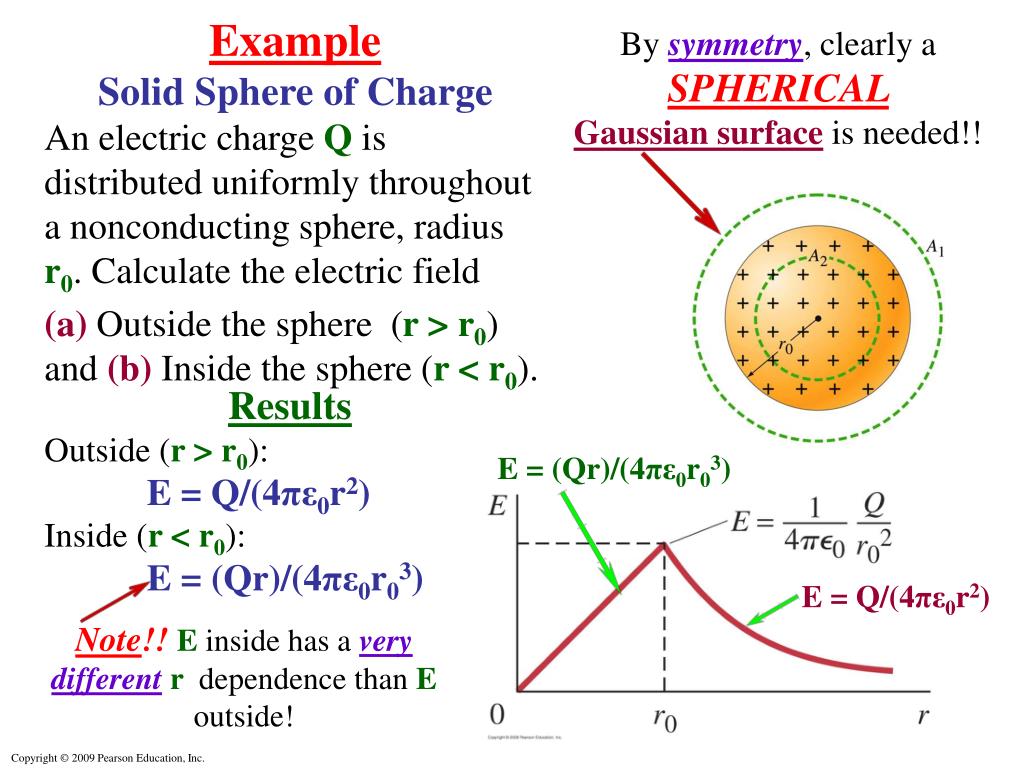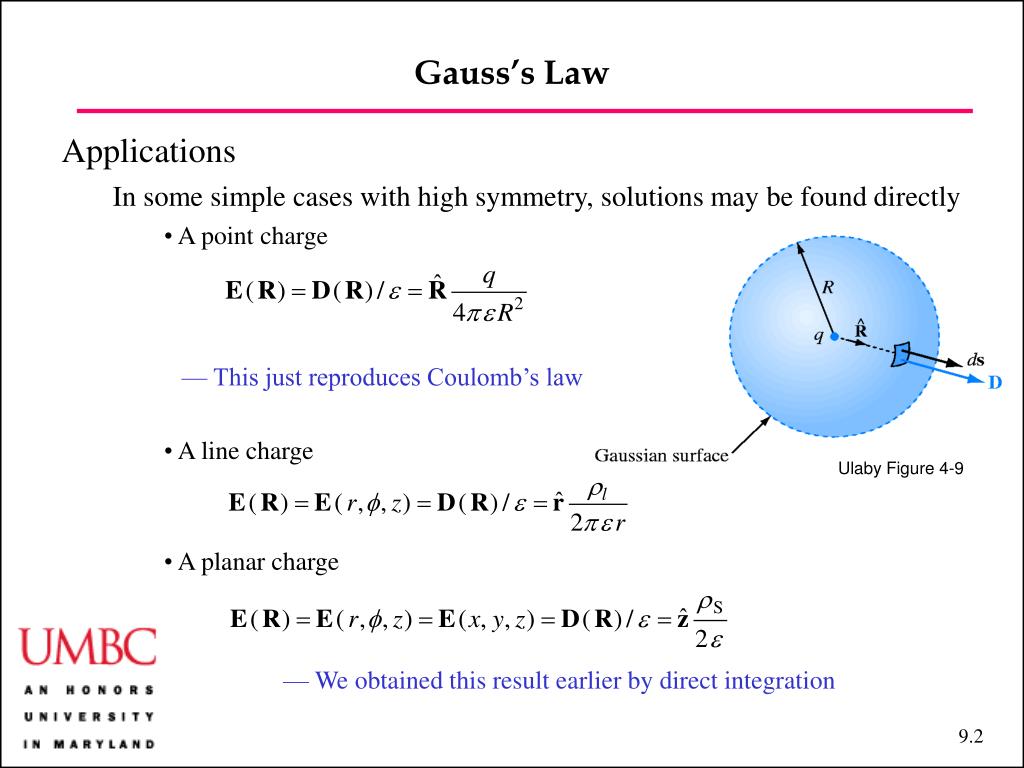Differential Form Of Gauss's Law
Differential Form Of Gauss's Law - Web gauss’ law in differential form (equation 5.7.3) says that the electric flux per unit volume originating from a point in space is equal to the volume charge density at that. Web the differential form is telling you that the number of field lines leaving a point is space is proportional to the charge density at that point. Gauss's law can be cast into another form that can be very useful. (all materials are polarizable to some extent.) when such materials are placed in an external electric field, the electrons remain bound to their respective atoms, but shift a microsco… Web gauss’ law (equation 5.5.1) states that the flux of the electric field through a closed surface is equal to the enclosed charge. Web that is the differential form of gauss’s law for e field. There is a theorem from vector calculus that states that the flux. (it is not necessary to divide the box exactly in half.) only the end cap. In contrast, bound charge arises only in the context of dielectric (polarizable) materials. Web local (differential) form of gauss's law.
Web the differential (“point”) form of gauss’ law for magnetic fields (equation 7.3.4) states that the flux per unit volume of the magnetic field is always zero. (it is not necessary to divide the box exactly in half.) only the end cap. Web local (differential) form of gauss's law. Gauss’s law for electricity states that the electric flux φ across any closed surface is. (7.3.1) ∮ s b ⋅ d s = 0 where b is magnetic. (a) write down gauss’s law in integral form. Web what the differential form of gauss’s law essentially states is that if we have some distribution of charge, (represented by the charge density ρ), an electric field. The electric charge that arises in the simplest textbook situations would be classified as free charge—for example, the charge which is transferred in static electricity, or the charge on a capacitor plate. Web gauss’s law, either of two statements describing electric and magnetic fluxes. Gauss's law can be cast into another form that can be very useful.
The integral form of gauss’ law states that the magnetic flux through a closed surface is zero. (7.3.1) ∮ s b ⋅ d s = 0 where b is magnetic. Web for an infinitesimally thin cylindrical shell of radius \(b\) with uniform surface charge density \(\sigma\), the electric field is zero for \(s<b\) and \(\vec{e}= \frac{\sigma b}{\epsilon_0 s}\,. The electric charge that arises in the simplest textbook situations would be classified as free charge—for example, the charge which is transferred in static electricity, or the charge on a capacitor plate. Web local (differential) form of gauss's law. Web 15.1 differential form of gauss' law. (it is not necessary to divide the box exactly in half.) only the end cap. (a) write down gauss’s law in integral form. Web maxwell's equations are a set of four differential equations that form the theoretical basis for describing classical electromagnetism:. Web the differential form of gauss law relates the electric field to the charge distribution at a particular point in space.
PPT Applications of Gauss’s Law PowerPoint Presentation, free
There is a theorem from vector calculus that states that the flux. Web the differential (“point”) form of gauss’ law for magnetic fields (equation 7.3.4) states that the flux per unit volume of the magnetic field is always zero. Web gauss’ law (equation 5.5.1) states that the flux of the electric field through a closed surface is equal to the.
PPT Gauss’s Law PowerPoint Presentation, free download ID1402148
Web the integral form of gauss’ law states that the magnetic flux through a closed surface is zero. Gauss’ law (equation 5.5.1) states that the flux of the electric field through a closed surface is equal. If you have an expression for the electric. Web the differential form of gauss law relates the electric field to the charge distribution at.
electrostatics Problem in understanding Differential form of Gauss's
Web gauss’s law, either of two statements describing electric and magnetic fluxes. Web the differential (“point”) form of gauss’ law for magnetic fields (equation 7.3.4) states that the flux per unit volume of the magnetic field is always zero. Web gauss’ law in differential form (equation 5.7.3) says that the electric flux per unit volume originating from a point in.
PPT Gauss’s Law PowerPoint Presentation, free download ID1402148
Web the differential (“point”) form of gauss’ law for magnetic fields (equation 7.3.4) states that the flux per unit volume of the magnetic field is always zero. Web section 2.4 does not actually identify gauss’ law, but here it is: Gauss’ law (equation 5.5.1) states that the flux of the electric field through a closed surface is equal. Web the.
Gauss' Law in Differential Form YouTube
The integral form of gauss’ law states that the magnetic flux through a closed surface is zero. Web gauss’ law in differential form (equation 5.7.3) says that the electric flux per unit volume originating from a point in space is equal to the volume charge density at that. Web draw a box across the surface of the conductor, with half.
Lec 19. Differential form of Gauss' law/University Physics YouTube
Web that is the differential form of gauss’s law for e field. When we look at the second equation which was the gauss’s law for magnetic field, b dot d a over a closed surface. Web local (differential) form of gauss's law. (it is not necessary to divide the box exactly in half.) only the end cap. (a) write down.
Gauss's law integral and differential form YouTube
The integral form of gauss’ law states that the magnetic flux through a closed surface is zero. Web what the differential form of gauss’s law essentially states is that if we have some distribution of charge, (represented by the charge density ρ), an electric field. Gauss’ law (equation 5.5.1) states that the flux of the electric field through a closed.
Differential Form of Gauss' Law (Calc 3 Connection) Equations
Gauss's law can be cast into another form that can be very useful. Web that is the differential form of gauss’s law for e field. Web gauss’s law, either of two statements describing electric and magnetic fluxes. Web gauss’ law (equation 5.5.1) states that the flux of the electric field through a closed surface is equal to the enclosed charge..
Solved Gauss's law in differential form relates the electric
There is a theorem from vector calculus that states that the flux. (all materials are polarizable to some extent.) when such materials are placed in an external electric field, the electrons remain bound to their respective atoms, but shift a microsco… Web gauss’s law, either of two statements describing electric and magnetic fluxes. When we look at the second equation.
Differential Form Of Gauss's Law l In Hindi YouTube
(it is not necessary to divide the box exactly in half.) only the end cap. Gauss's law can be cast into another form that can be very useful. Web differential form of gauss’s law according to gauss’s theorem, electric flux in a closed surface is equal to 1/ϵ0 times of charge enclosed in the surface. \end {gather*} \begin {gather*} q_..
If You Have An Expression For The Electric.
Web gauss’ law in differential form (equation 5.7.3) says that the electric flux per unit volume originating from a point in space is equal to the volume charge density at that. The electric charge that arises in the simplest textbook situations would be classified as free charge—for example, the charge which is transferred in static electricity, or the charge on a capacitor plate. Web that is the differential form of gauss’s law for e field. Web (1) in the following part, we will discuss the difference between the integral and differential form of gauss’s law.
Gauss's Law Can Be Cast Into Another Form That Can Be Very Useful.
Web differential form of gauss’s law according to gauss’s theorem, electric flux in a closed surface is equal to 1/ϵ0 times of charge enclosed in the surface. When we look at the second equation which was the gauss’s law for magnetic field, b dot d a over a closed surface. Web what the differential form of gauss’s law essentially states is that if we have some distribution of charge, (represented by the charge density ρ), an electric field. There is a theorem from vector calculus that states that the flux.
Web Gauss’s Law, Either Of Two Statements Describing Electric And Magnetic Fluxes.
Web gauss’ law (equation 5.5.1) states that the flux of the electric field through a closed surface is equal to the enclosed charge. (a) write down gauss’s law in integral form. \begin {gather*} \int_ {\textrm {box}} \ee \cdot d\aa = \frac {1} {\epsilon_0} \, q_ {\textrm {inside}}. Web maxwell's equations are a set of four differential equations that form the theoretical basis for describing classical electromagnetism:.
Gauss’ Law Is Expressed Mathematically As Follows:.
Web section 2.4 does not actually identify gauss’ law, but here it is: Web the differential form of gauss law relates the electric field to the charge distribution at a particular point in space. Gauss’s law for electricity states that the electric flux φ across any closed surface is. (all materials are polarizable to some extent.) when such materials are placed in an external electric field, the electrons remain bound to their respective atoms, but shift a microsco…









